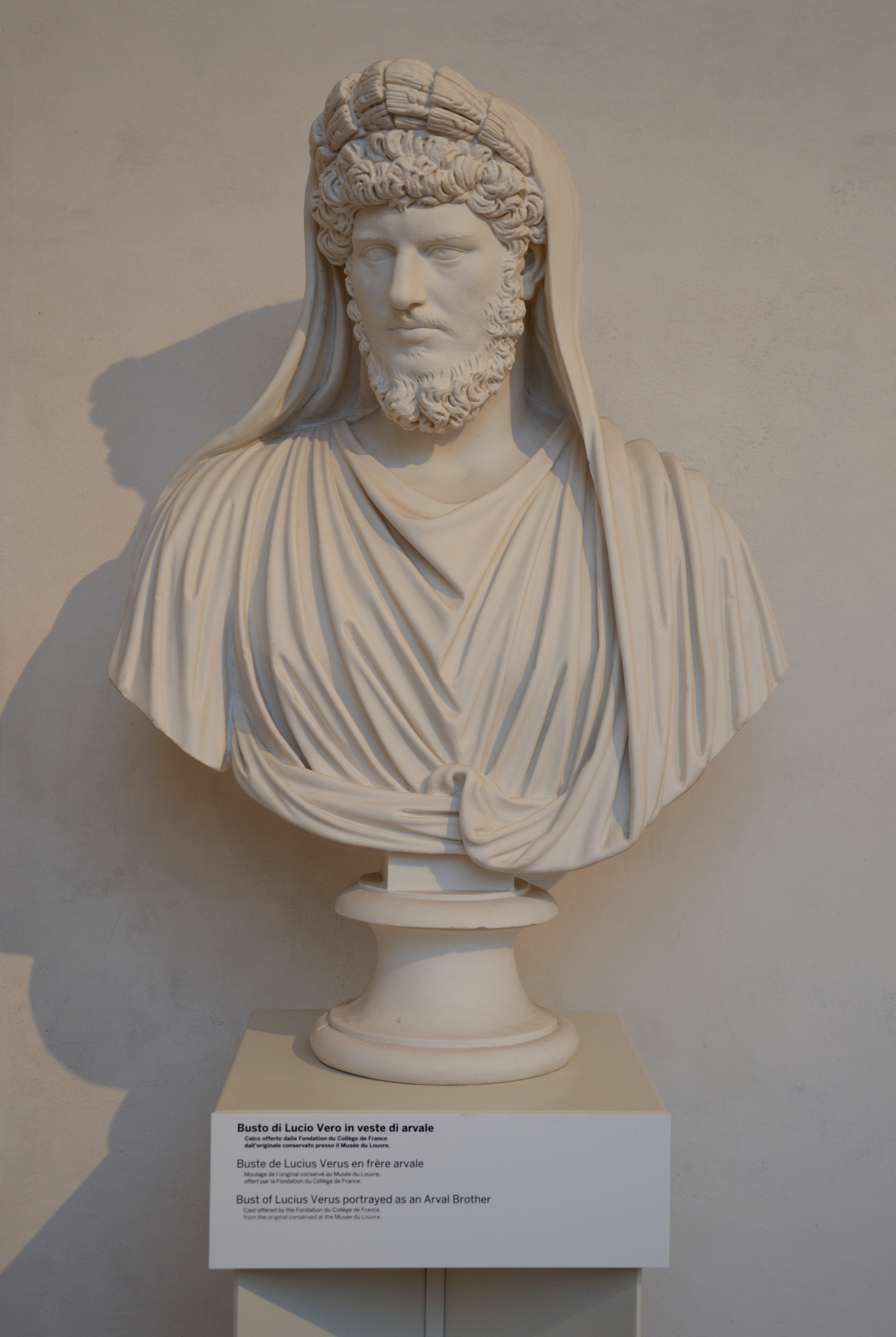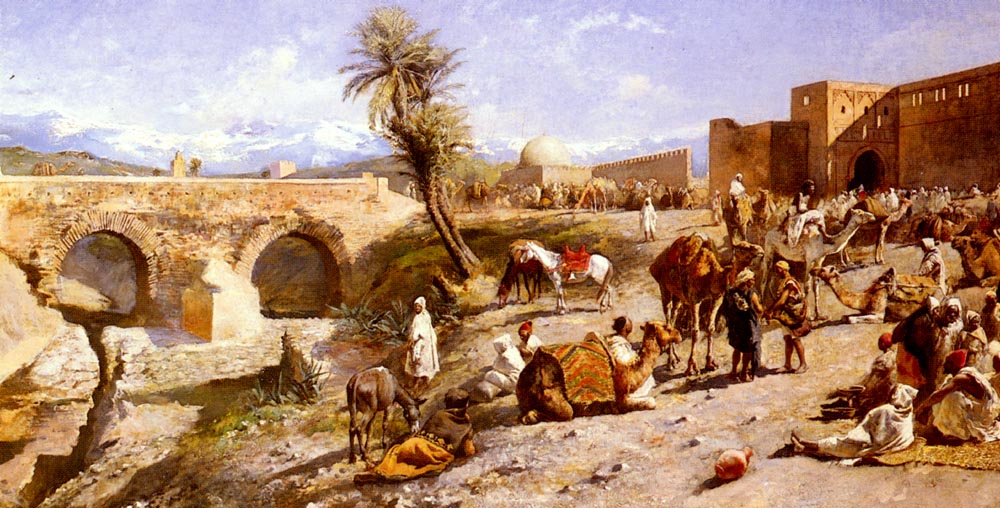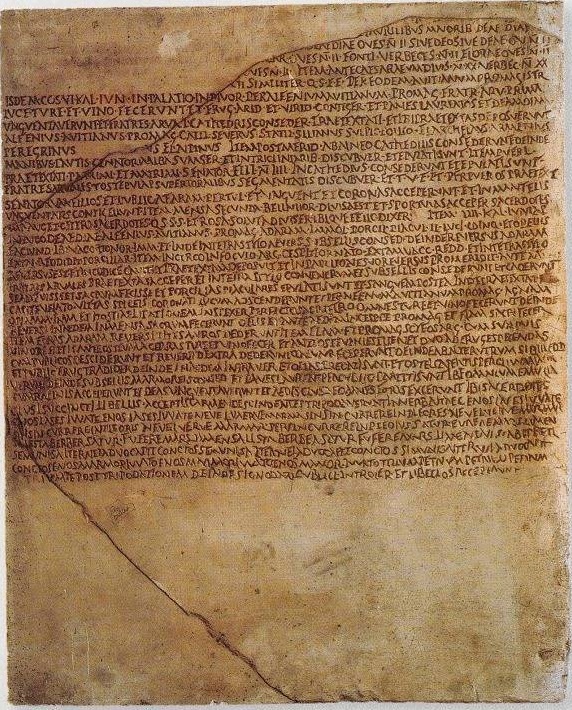|
Ambarvalia
Ambarvalia was a Roman agricultural fertility rite held on 29 May in honor of Ceres and Dea Dia. At these festivals they sacrificed a bull, a sow, and a sheep, which, before the sacrifice, were led in procession thrice around the fields; whence the feast is supposed to have taken its name, ''ambiō'', "I go around," and ''arvum'', field. This sacrifice was called a '' suovetaurilia'' in Latin Latin (, or , ) is a classical language belonging to the Italic branch of the Indo-European languages. Latin was originally a dialect spoken in the lower Tiber area (then known as Latium) around present-day Rome, but through the power .... These feasts were of two kinds, public and private. The private were solemnized by the masters of families, accompanied by their children and servants, in the villages and farms out of Rome. The public were celebrated in the boundaries of the city, and in which twelve '' fratres arvales'' walked at the head of a procession of the citizen ... [...More Info...] [...Related Items...] OR: [Wikipedia] [Google] [Baidu] |
Ambarvalia Sacrifice Relief By Alberto Pisa (1905)
Ambarvalia was a Roman agricultural fertility rite held on 29 May in honor of Ceres and Dea Dia. At these festivals they sacrificed a bull, a sow, and a sheep, which, before the sacrifice, were led in procession thrice around the fields; whence the feast is supposed to have taken its name, ''ambiō'', "I go around," and ''arvum'', field. This sacrifice was called a ''suovetaurilia'' in Latin. These feasts were of two kinds, public and private. The private were solemnized by the masters of families, accompanied by their children and servants, in the villages and farms out of Rome. The public were celebrated in the boundaries of the city, and in which twelve ''fratres arvales'' walked at the head of a procession of the citizens, who had lands and vineyards at Rome. During the procession, prayers would be made to the goddess. The '' ambervale carmen'' was a prayer preferred on this occasion. The name "Ambarvalia" appears to be predominantly an urban designation. Roman farmers' alm ... [...More Info...] [...Related Items...] OR: [Wikipedia] [Google] [Baidu] |
Amburbium
The Amburbium ("City Circuit", from ''ambire'', "to go around" + ''urb-'', "city"; plural ''amburbia'') was an ancient Roman festival for purifying the city; that is, a lustration ''(lustratio urbis)''. It took the form of a procession, perhaps along the old Servian Wall, though the length of 10 kilometers would seem impractical to circumambulate. If it was a distinct festival held annually, the most likely month is February, but no date is recorded and the ritual may have been performed as a "crisis rite" when needed. The Amburbium can be hard to distinguish from the Ambarvalia in ancient sources, either because it was a similar set of ritual procedures performed on behalf of the city instead of the fields or rural areas ''(arva)'', or because both originated with the priesthood of the Arvales, "Brothers of the Fields". Vopiscus sees the two as closely related: "the city is purified, the hymns are chanted, the Amburbium is celebrated, the Ambarvalia is carried out." Both festi ... [...More Info...] [...Related Items...] OR: [Wikipedia] [Google] [Baidu] |
Dea Dia
Dea Dia (Latin: "Goddess of Daylight", or "Bright Goddess") was a goddess of fertility and growth in ancient Roman religion. She was sometimes identified with Ceres, and sometimes with her Greek equivalent Demeter. She was worshiped during Ambarvalia, a festival to Ceres. Every May, her priests, the Fratres Arvales In ancient Roman religion, the Arval Brethren ( la, Fratres Arvales, "Brothers of the Fields") or Arval Brothers were a body of priests who offered annual sacrifices to the Lares and gods to guarantee good harvests. Inscriptions provide evide ..., held a three-day festival in her honor.Notes on Strabo's account 5.3/ref> Name The name ''Dea Dīa'' () means 'Goddess of Daylight' or 'Bright Goddess'. The first element stems from the Latin ''dea'' ('goddess'), while the second is related to ''diēs'' ('day'), probably in reference to the ritual prescription to announce in January the May ceremonies ''sub divo culmine'' ('under the celestial vault'). See also * ... [...More Info...] [...Related Items...] OR: [Wikipedia] [Google] [Baidu] |
Ceres (mythology)
In ancient Roman religion, Ceres ( , ) was a goddess of agriculture, grain crops, fertility and motherly relationships.Room, Adrian, ''Who's Who in Classical Mythology'', p. 89-90. NTC Publishing 1990. . She was originally the central deity in Rome's so-called plebeian or Aventine Triad, then was paired with her daughter Proserpina in what Romans described as "the Greek rites of Ceres". Her seven-day April festival of Cerealia included the popular '' Ludi Ceriales'' (Ceres' games). She was also honoured in the May '' lustratio'' of the fields at the Ambarvalia festival, at harvest-time, and during Roman marriages and funeral rites. She is usually depicted as a mature woman. Ceres is the only one of Rome's many agricultural deities to be listed among the Dii Consentes, Rome's equivalent to the Twelve Olympians of Greek mythology. The Romans saw her as the counterpart of the Greek goddess Demeter,''Larousse Desk Reference Encyclopedia'', The Book People, Haydock, 1995, p. ... [...More Info...] [...Related Items...] OR: [Wikipedia] [Google] [Baidu] |
Roman Festivals
Festivals in ancient Rome were a very important part in Roman religious life during both the Republican and Imperial eras, and one of the primary features of the Roman calendar. ''Feriae'' ("holidays" in the sense of "holy days"; singular also ''feriae'' or ''dies ferialis'') were either public ''(publicae)'' or private ''( privatae)''. State holidays were celebrated by the Roman people and received public funding. Games ''( ludi)'', such as the Ludi Apollinares, were not technically ''feriae'', but the days on which they were celebrated were '' dies festi'', holidays in the modern sense of days off work. Although ''feriae'' were paid for by the state, ''ludi'' were often funded by wealthy individuals. ''Feriae privatae'' were holidays celebrated in honor of private individuals or by families. This article deals only with public holidays, including rites celebrated by the state priests of Rome at temples, as well as celebrations by neighborhoods, families, and friends held ... [...More Info...] [...Related Items...] OR: [Wikipedia] [Google] [Baidu] |
Processions In Ancient Rome
A procession is an organized body of people walking in a formal or ceremonial manner. History Processions have in all peoples and at all times been a natural form of public celebration, as forming an orderly and impressive ceremony. Religious and triumphal processions are abundantly illustrated by ancient monuments, e.g. the religious processions of Egypt, those illustrated by the rock-carvings of Boghaz-Keui, the many representations of processions in Greek art, culminating in the great Panathenaic procession of the Parthenon Frieze, and Roman triumphal reliefs, such as those of the arch of Titus. Greco-Roman practice Processions played a prominent part in the great festivals of Greece, where they were always religious in character. The games were either opened or accompanied by more or less elaborate processions and sacrifices, while processions from the earliest times formed part of the worship of the old nature gods, as those connected with the cult of Dionysus and the Ph ... [...More Info...] [...Related Items...] OR: [Wikipedia] [Google] [Baidu] |
May Observances
May is the fifth month of the year in the Julian and Gregorian calendars and is the third of seven months to have a length of 31 days. May is a month of spring in the Northern Hemisphere, and autumn in the Southern Hemisphere. Therefore, May in the Southern Hemisphere is the seasonal equivalent of November in the Northern Hemisphere and vice versa. Late May typically marks the start of the summer vacation season in the United States ( Memorial Day) and Canada ( Victoria Day) that ends on Labor Day, the first Monday of September. May (in Latin, ''Maius'') was named for the Greek goddess Maia, who was identified with the Roman era goddess of fertility, Bona Dea, whose festival was held in May. Conversely, the Roman poet Ovid provides a second etymology, in which he says that the month of May is named for the ''maiores,'' Latin for "elders," and that the following month (June) is named for the ''iuniores,'' or "young people" (''Fasti VI.88''). Eta Aquariids meteor sho ... [...More Info...] [...Related Items...] OR: [Wikipedia] [Google] [Baidu] |
Carmen Arvale
The ''Carmen Arvale'' is the preserved chant of the Arval priests or ''Fratres Arvales'' of ancient Rome. The Arval priests were devoted to the goddess Dia, and offered sacrifices to her to ensure the fertility of ploughed fields (Latin ''arvum''). There were twelve Arval priests, chosen from patrician families. During the Roman Empire the Emperor was always an Arval priest. They retained the office for life, even if disgraced or exiled. Their most important festival, the Ambarvalia, occurred during the month of May, in a grove dedicated to Dia. The ''Carmen Arvale'' is preserved in an inscription dating from 218 AD, which contains records of the meetings of the Arval Brethren. It is written in an archaic form of Old Latin, likely not fully understood any more at the time the inscription was made. One of its interpretations goes as follows: :''enos Lases iuuate'' :''enos Lases iuuate'' :''enos Lases iuuate'' :''neue lue rue Marmar sins incurrere in pleores'' :''neue lu ... [...More Info...] [...Related Items...] OR: [Wikipedia] [Google] [Baidu] |
Fratres Arvales
In ancient Roman religion, the Arval Brethren ( la, Fratres Arvales, "Brothers of the Fields") or Arval Brothers were a body of priests who offered annual sacrifices to the Lares and gods to guarantee good harvests. Inscriptions provide evidence of their oaths, rituals and sacrifices. Origin Roman legend held that the priestly college was originated by Romulus, first king of Rome, who took the place of a dead son of his nurse Acca Laurentia, and formed the priesthood with the remaining eleven sons. They were also connected originally with the Sabine priesthood of ''Sodales Titii'' who were probably originally their counterpart among the Sabines. Thus, it can be inferred that they existed before the founding of the city.Aulus Gellius VII 7, 7; Pliny XVII 2, 6. There is further proof of the high antiquity of the college in the verbal forms of the song with which, down to late times, a part of the ceremonies was accompanied, and which is still preserved. They persisted to the im ... [...More Info...] [...Related Items...] OR: [Wikipedia] [Google] [Baidu] |
Suovetaurilia
The or was one of the most sacred and traditional rites of Roman religion: the sacrifice of a pig (), a sheep () and a bull () to the deity Mars to bless and purify land (). Summary There were two kinds: * ("suckling suovetaurilia") of a male pig, a lamb and a calf, for purifying private fields * ("greater suovtaurilia") of a boar, a ram and a bull, for public ceremonies. The ritual for private fields is preserved in Cato the Elder's , "On Agriculture". The first step was to lead the three animals around the boundaries of the land to be blessed, pronouncing the following words: : :"That with the good help of the gods success may crown our work, I bid thee, Manius, to take care to purify my farm, my land, my ground with this suovetaurilia, in whatever part thou thinkest best for them to be driven or carried around." "Manius" in this passage may be an obscure minor deity, related to the Manes, or may be the equivalent of English John Doe. Then, before the sacrifice ... [...More Info...] [...Related Items...] OR: [Wikipedia] [Google] [Baidu] |
Latin
Latin (, or , ) is a classical language belonging to the Italic branch of the Indo-European languages. Latin was originally a dialect spoken in the lower Tiber area (then known as Latium) around present-day Rome, but through the power of the Roman Republic it became the dominant language in the Italian region and subsequently throughout the Roman Empire. Even after the fall of Western Rome, Latin remained the common language of international communication, science, scholarship and academia in Europe until well into the 18th century, when other regional vernaculars (including its own descendants, the Romance languages) supplanted it in common academic and political usage, and it eventually became a dead language in the modern linguistic definition. Latin is a highly inflected language, with three distinct genders (masculine, feminine, and neuter), six or seven noun cases (nominative, accusative, genitive, dative, ablative, and vocative), five declensions, four ... [...More Info...] [...Related Items...] OR: [Wikipedia] [Google] [Baidu] |
Sacrifice
Sacrifice is the offering of material possessions or the lives of animals or humans to a deity as an act of propitiation or worship. Evidence of ritual animal sacrifice has been seen at least since ancient Hebrews and Greeks, and possibly existed before that. Evidence of ritual human sacrifice can also be found back to at least pre-Columbian civilizations of Mesoamerica as well as in European civilizations. Varieties of ritual non-human sacrifices are practiced by numerous religions today. Terminology The Latin term ''sacrificium'' (a sacrifice) derived from Latin ''sacrificus'' (performing priestly functions or sacrifices), which combined the concepts ''sacra'' (sacred things) and ''facere'' (to do or perform). The Latin word ''sacrificium'' came to apply to the Christian eucharist in particular, sometimes named a "bloodless sacrifice" to distinguish it from blood sacrifices. In individual non-Christian ethnic religions, terms translated as "sacrifice" include the Indic ... [...More Info...] [...Related Items...] OR: [Wikipedia] [Google] [Baidu] |









